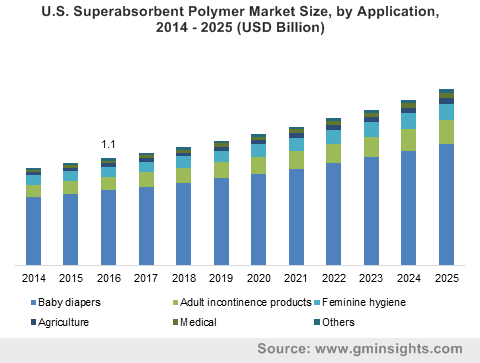Superabsorbent polymers market to garner commendable proceeds from baby diaper sales by 2024, global industry landscape to be characterized by enormous investment bids and innovative research programs
Publisher : Fractovia | Published Date : 2018-10-12Request Sample
Predominantly driven by increasing usage in baby diapers, adult incontinence, and female hygiene products, the superabsorbent polymers market has been gradually emerging as one of the most enterprising niche verticals of polymers and advanced materials industry. Lately, it has been observed that major chemical firms have been investing heavily to develop biodegradable superabsorbent polymers as the conventional polymers are being increasingly termed as environmentally harmful by researchers around the globe. Below is a brief overview of how a surge in R&D investments by leading corporations would propel superabsorbent polymers industry trends in the years ahead:
U.S. Superabsorbent Polymer Market Size, by Application, 2014 – 2025 (USD Billion)

- In 2014, the German chemical giant BASF announced an investment of around USD 625 million in order to optimize the overall process of manufacturing superabsorbent polymers and revamp its existing facilities. The company had stated that it has been working on a pioneering superabsorbent technology platform within its hygiene business and plans to set up droplet polymerization capabilities in the years ahead. The researchers of the company have been working extensively over the last decade to develop new superabsorbent polymers under its flagship SAVIVATM variant. Reportedly, these polymers have demonstrated high-efficiency and performance in diaper prototypes owing to unique distribution mechanism.
- One of the major superabsorbent polymers market participant Evonik has recently invested approximately 1 million Euros to construct a new application technology facility in Germany. The new laboratory would fortify target-oriented innovation efforts and product knowledge of the company along with drastic enhancement in the implementation of new test methods. Reportedly, these new methods enable application of real-time conditions in the standardized laboratory evaluation of a broad range of incontinence products. With a highly-efficient laboratory in place, Evonik now aims to widen the scope of its superabsorbent polymers beyond baby diapers and adult incontinence products.
- In 2017, LG Chem Limited had announced to invest approximately USD 278 million to expand the annual manufacturing capacity of super absorbent polymer and crude acrylic acid at its facility in the southern part of the nation. Regarded as one of the foremost chemical firms of South Korea, the company plans to increase the production of superabsorbent polymer by 100,000 tons in the upcoming years. Reportedly, the expansion is slated to be completed by the end of 2019 and would assist the firm to acquire a dominant position in the global superabsorbent polymers industry in the times to come.
One of the major applications of superabsorbent polymers market are the adult incontinence products and baby diapers. The usage of these products has been on the rise lately owing to increasing hygiene awareness and the constant surge in birth rate globally. In fact, as per reliable estimates, baby diapers apportioned around 70% of the total revenue share of the industry in the year 2017. In this context, it would be prudent to mention that the safe disposal of diapers has emerged as a serious environmental concern in the recent years as they are manufactured using synthetic materials which are predominantly non-biodegradable. Several prominent research institutions around the globe have been making concerted efforts to find alternate solutions for the synthetic materials owing to increased focus on sustainability and growing demand for biodegradable polymers.
For instance, the researchers from the Department of Chemistry at the Indian Institute of Technology in Madras have recently developed a biodegradable superabsorbent polymer which can absorb up to 1250 grams of water for each gram of its weight. Christened as CHCAUR, the superabsorbent has been manufactured utilizing bio-based products such as urea, citric acid, and chitosan. The newly developed polymer is being regarded as a significant breakthrough for the overall superabsorbent polymer industry as its water absorption capability is nearly eight times more compared to super-absorbing polymers currently being used in manufacturing diapers. Needless to mention, the launch of such innovative and environment friendly polymers would significantly increase the efficiency of adult incontinence products and baby diapers in the times to come.
Considering the aforementioned instances of innovative research activities, massive investment programs coupled with capacity expansion strategies undertaken by leading chemical firms, the growth prospects of the superabsorbent polymers market undoubtedly appear promising. In fact, as per a research study compiled by Global Market Insights, Inc., the remuneration portfolio of superabsorbent polymers industry is forecast to exceed USD 9.5 billion by 2025.